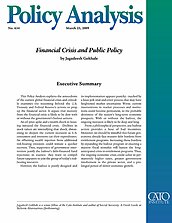An oil price spike and a wealth shock in housing initiated the financial crisis. Declines in stock values are intensifying that shock, threatening to deepen the current recession as U.S. consumers and investors cut their expenditures. An offsetting wealth injection from additional risk-bearing investors could initiate a quicker recovery. Thus, supporters of government intervention justify the bailout’s debt-financed fund injections — in essence, they want to compel future taxpayers to join the group of today’s riskbearing investors.
However, the bailout is poorly designed and its implementation appears panicky — marked by a knee-jerk trial-and-error process that may have heightened market uncertainty. Worse, current interventions in market processes and institutions could become permanent, to the probable detriment of the nation’s long-term economic prospects. With or without the bailout, the ongoing recession is likely to be deep and long.
From a philosophical perspective, any bailout action provides a host of bad incentives. Moreover, we should be mindful that future generations already face massive debt burdens from entitlement programs. Increasing those burdens by expanding the bailout program or enacting a massive fiscal stimulus will hasten the long-anticipated crisis in entitlement programs. Thus, the ongoing economic crisis could usher in permanently higher taxes, greater government involvement in the private sector, and a prolonged period of slower economic growth.


